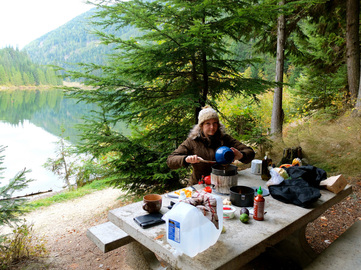 our temporary home on the lake
our temporary home on the lake  our temporary home on the lake our temporary home on the lake So off we went to Nelson BC to start a new adventure. We spent the first night camped out at Cottonwood Lake since we hadn't been very good at keeping in touch with the farms or couchsurfer hosts that we had contacted prior to arriving - normally they like to have a few days notice but our plans changed too often to stick to one. It was nice though, a peaceful little lake with some picnic tables. There were a few groups of people enjoying the sunny day who were all very interested in chatting with us. The next day we found a place with internet and noticed that we got a response from someone who could host us that night in her spare bedroom. We were so happy to meet Gabrielle who cooked us up a delicious dinner and told us about the many hiking trails around Nelson. We were expecting to stay for only a day or two before heading out to Chuckleberry Farm to volunteer for a week or two before my yoga course started, but in the morning Gabrielle informed us that there was a family emergency and she had to take off for a few days. Unfortunate news, but we were very happy to stick around and look after her beautiful little place while she was away. Before Gabrielle left she put us in contact with her daughter, Vida, and a friend who couch sat with her a year earlier, Peter, who is also a mechanical engineer and now lives in Nelson. After meeting Peter a few times Peter mentioned that he had just bought a house and would be moving in soon. He hinted that it had two extra bedrooms and we took the bait, agreeing that after our time at Chuckleberry Farm we would stay in Nelson with him during the yoga course. It was so funny because we had been getting a little worried that we hadn't planned enough for this trip but suddenly, things were falling into place. Gabrielle's neighbours even invited us over for a very lovely potlach Thanksgiving dinner. Nelson was slowly but surely taking us in.
4 Comments
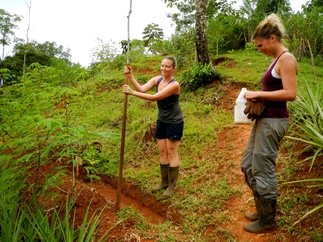 working hard while on vacation?! working hard while on vacation?! Let’s face it; volunteering our time and effort to a worthy cause is a nice, feel-good thing to do. For many of us, however, the idea of doing work when we could otherwise be relaxing on a beach or exploring the jungle just sounds … crazy. We travel to enjoy life, not to waste our precious time milking cows or digging trenches. Well, not only can volunteering let you to contribute directly to a cause you’re passionate about, it can also be a great addition to your travels, providing unique and rewarding experiences as well as a means of stretching your travel budget. Remember, too, that volunteering is an exchange, meaning that not only is your host benefitting from your hard work, enthusiasm and great ideas; you’re also honing a new set of skills while gaining a different perspective on life. If simply helping to make the world a better place isn’t reason enough, here are five completely selfish reasons to give volunteering a try on your next trip. To Save Money free rainforest accommodation! free rainforest accommodation! Volunteering can be a great way to save some money and let you stretch out your travels. In exchange for just a few hours’ work a day, you can score delicious home-cooked meals and a comfortable bed, letting you hang out and explore a new place for weeks without spending a dime. This can be an awesome deal, especially when you’re working with a fun group of people on something you enjoy. Unfortunately, depending on where you are in the world and what kind of volunteering gig you’re looking for, this isn’t always the way it will work. In some situations, the value of your work (despite the fact that you’re giving it your all) just can’t cover the full cost of keeping you around. Because of this, many volunteer hosts will ask you to contribute a small fee during your stay. This may sound unreasonable at first, but if you consider the host’s point of view you may understand. 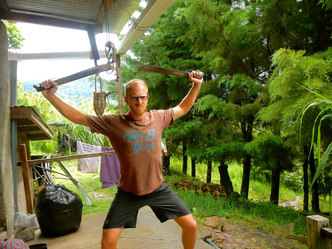 warming up for some machete work warming up for some machete work We spent a few weeks volunteering at a family-run organic farm in Costa Rica, working our butts off for five hours a day AND paying $12 U.S. per day for the right to do it. It took a while for us to swallow this, but once we’d learned more about the local situation (and found the awesome experience made it worthwhile) we quickly came to terms with it. Part of the issue is the fact that a local could be hired to do the work for the equivalent of two U.S. dollars per hour, and could do it a heck of a lot faster, at that (no matter how hard-working and well-intentioned you are, after an hour of cutting grass with a machete, you’re soaked in sweat with a sprained back and wrist while the local worker has cleared three times the area and hasn’t slowed down a bit). The other problem is the relatively high cost of living in Costa Rica; we would’ve spent a small fortune to stay in a hostel or eco-lodge in a similar area. On the bright side, the fee you pay can go straight to work helping out the local economy, providing your host with the means to employ a local worker (hopefully saving you from machete-mowing duty in the first place).
Don’t be afraid to pay a small amount, as long as it seems reasonable – if they’re asking for way more than it could possibly cost to host you, however, either ask them to explain where the money goes or simply steer clear. If completely free is a requirement, though, be persistent and you’ll find something. Countries with a lower cost of living will offer more affordable options, as will volunteer gigs with more profitable ventures (hotels or restaurants generally make more money than independently-owned organic farms). Also keep in mind that many hosts will be willing to work out a special deal if you prove especially useful or are able to stick around for longer. Bonus points if you’ve got some relevant skills from your past life – even if it’s just rewiring a couple light switches in your friend’s apartment back at home, you may find you’re the most experienced electrician in town. On a related note, try not to touch the exposed wires on your electrically heated showerhead… 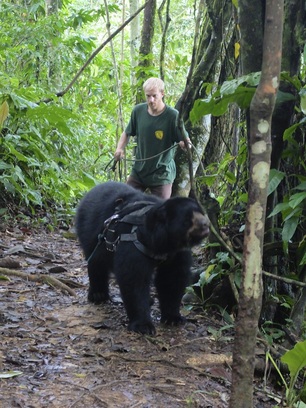 my first day on the ropes my first day on the ropes Imagine a volunteering gig where your only job is to spend your days hanging out with a couple good friends while walking a cute and cuddly dog through the Bolivian jungle. "Sounds great, sign me up!" you say? Not so fast... replace that cuddly dog with Balu, a fully-grown male Andean bear with a serious addiction to coca leaves and backpacks. Next, swap those good friends with a couple dudes you've just met, neither of which are in any way qualified to be working with a bear. Finally, factor in Balu's cunning and constant desire to catch you and engage in a very one-sided wrestling match. Still sound like fun? Glad to see that great minds think alike! Before you slip into your rubber boots and plunge headfirst into the jungle, check out the following survival tips: Check your common sense at the door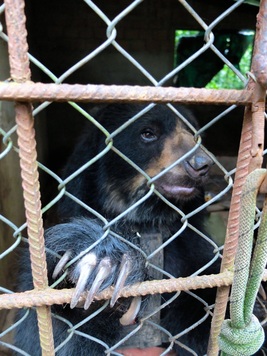 "let me out, I'm HUNGRY!" "let me out, I'm HUNGRY!" You and your two newly met teammates are about to release a three-hundred pound bear from his reinforced steel and brick enclosure with nothing but a ten meter rope and a backpack full of peanuts, fruit, and a quadruple-sealed bag of coca leaves (only to be used in SERIOUS emergencies) to keep him under control. Such a feat requires either nerves of steel or, more likely, blissful ignorance. Take things one day at a time, and keep in mind that in his eight years at Comunidad Inti Wara Yassi, a wildlife refuge in Bolivia, Balu's never injured a volunteer to the point of needing stitches (the same can’t be said for a few unlucky coca-fueled construction workers). Don't get caught Balu is quite playful, and one of his favourite games is trying to catch his volunteers (just to play, don't worry...?). He's also smarter than he looks, and will try to catch you off guard with a surprise sprint forward, a quick run back, or, on his more devious days, a surprise sprint forward followed by a quick run back (a combo which can catch even the most careful of volunteers off guard). Whether Balu's simply feeling playful or, god forbid, angry or frustrated, and despite everyone's insistence that he won't do any serious harm, you DO NOT want to get caught. Although Balu's likely to catch you at least once over the course of your month-long volunteering gig, do your best to avoid this, as it's pants-shittingly terrifying and will likely leave your favourite jungle wardrobe torn to shreds.
Some things to keep in mind in order to avoid Balu's rib-crushing bear hug: 1) Keep your distance. Although Balu can outrun you with enough motivation, he’s rather lazy and a bit overweight, and so will only try to catch you if it won't leave him out of breath. Maintain a reasonable distance and you should be safe.  How was I ever afraid of her How was I ever afraid of her My job for the month at Comunidad Inti Wara Yassi (CIWY) was to walk with Tigre (with her because she leads) in the jungle every day. Before starting my first day I was told that Tigre doesn't take trails, is very energetic, hunts and typically gets her handlers lost in the jungle overnight at least once during their stay. I was also warned how violent she can be. On the day that we arrived, the girl who was currently training to walk with Tigre was attacked pretty badly (stitches on her arms and possibly other places, I didn't really want to know more). Alarm bells started ringing in my head but something inside me told me this is something I had to do. Walking alone in the jungle with a wild cat has been a fantasy of mine for about for as long as I can remember, and only now have I realized that it is something I will really be able to do!  I wish someone had told me how gentle and patient Tigre can be, because this is the Tigre I soon got to know and love. From the moment we arrived at CIWY all I heard were horror stories about how violent she is and how other volunteers had gotten lost in the jungle overnight because of her. Still, it wasn't until I began to work with her that my subconscious fears began to surface to the point that I nearly gave up. I had imagined a much more relaxed experience. Naive, I now know.
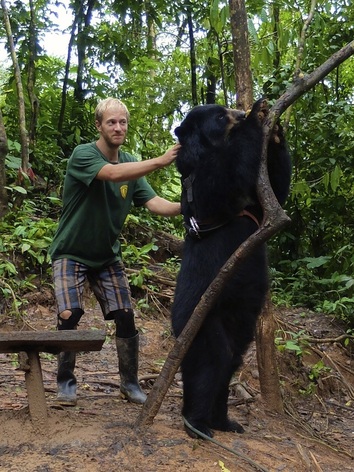 Mandrew bonding with his project, Balu Mandrew bonding with his project, Balu We first read about Comunidad Inti Wara Yassi (CIWY) in a guest book at cozy coffee shop in Copacabana about a week before we decided to go there. We were on the lookout for some sort of volunteer gig, but weren't terribly inspired by the various organic farming options we'd found online. Although it wasn't something we'd really considered, we jumped at the idea of working with jungle animals! Looking into the organization further we were touched by the story of how a Bolivian couple in the late 1980's, in the hopes of making a difference in Bolivia, established a school of alternative education outside of La Paz for the many children of miners who had relocated to the area. After being exposed to the lush surrounding rainforest and its ruthless destruction, the children vowed to protect the fragile rainforest and its animals through a campaign of education and awareness. During a later field trip to Rurrenabaque, the project took an important shift after the kids pooled together their meagre funds to purchase and rescue a spider monkey from its local owners who were forcing it to drink alcohol and dance for their amusement. Over the next few years, a number of other animals were adopted and rescued, despite the constant struggle to figure out what to do with them. Finally, Parque Machia, the first wildlife refuge in Bolivia, was established. For nearly 20 years now, professionals and volunteers from all over the world have been supporting this cause through the raising of funds and the donating of time. The organization now manages three parks in Bolivia where upwards of 500 animals of over 30 different species (including bears, cats, birds, monkeys, coatis, and foxes) are cared for.  Chelsea and Tigre chillin' in the jungle Chelsea and Tigre chillin' in the jungle A few days after reading the guest book in Copacabana we saw a poster for CIWY at our hostel in La Paz, and soon after ran into a guy who knew a guy who had volunteered with them and spent a month walking a puma. By then the seed of the idea had sprouted and taken root, and we found ourselves packing our bags. After a long day of bussing through Cochabamba and beyond, we arrived in Villa Tunari late in the evening and crawled to the closest hostel to hide from the torrential downpour that welcomed us. In the morning we walked across the bridge looking for the CIWY office, only to walk right past it. It was not marked well and looked more like an abandoned concrete structure with graffiti all over it.
We were quick to forgive the outer appearance of the office after being hailed by other volunteers watching from the cafe. On the inside, the place was humming with activity: volunteers chopping food for the monkeys, hauling hay and trees for the cats and bear, unloading endless truckloads of bananas, and disposing of bucketfuls of animal waste. Everyone looked very enthusiastic! 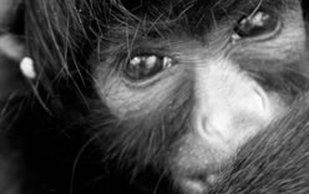 image taken from www.intiwarayassi.com image taken from www.intiwarayassi.com For the next four weeks we’ll be volunteering at a wildlife reserve called Inti Wara Yassi in the small town of Villa Tunari in Bolivia. Only in Bolivia (or another developing country, I suppose) could a place like this exist, where unqualified but willing volunteers can, after only a short lesson from other volunteers, work with and handle wild animals. We arrive partway through the workday and kill some time in the outdoor cafeteria where breakfasts, lunches, and after work beers are available. While surveying our new surroundings, we take in the graffiti from past volunteers which covers the nearby walls, including things like “Tigre the Lostalot Ocelot”, “Quaranteam 2013”, “Monkey Love”, “small (but vicious) animals”, and “Badass Balu”, and wonder what we’re about to get ourselves into.
As the workday wraps up and the volunteers straggle into the café, we strike up a conversation hoping to learn more about the volunteer experience. A couple realities quickly sink in: there will be a lot of dealing with poop, and, at some point, we’re likely to pick up a minor wound (making for an interesting scar story once we’re back at home). One of the volunteers, a skinny redhead from Australia, eagerly describes his latest encounter with a fox while working in the small animal section. While attempting to get a collar around the fox’s neck (after days in a cage, he figured it would enjoy a nice walk), the fox decided it didn’t like what was going on. After a couple quick bites to the shin (through a rubber boot), the fox clamped its jaws on the aussie’s forearm and hung on for dear life. No lasting damage was done, and we’re assured that the on-site vets are very skilled at stitching up both animals and humans. Finally, 4:30 rolls around and we’re led on a quick tour of the facilities which include: quarantine, containing about eighty capuchin monkeys, some in cages and some tied up on runners (not to mention the dozen or more wild ones that hang out hoping to snag food from the residents); the aviary, where macaws, toucans, and parrots are guarded from hungry wild monkeys by a well-trained dog; and a sizeable area for land and water turtles. We´re also told about other areas in which a number of coatis, two ocelots, one puma, and an Andean bear are kept (but which aren´t included in the express tour). We are then sat down and asked by Marta, the volunteer coordinator, to fill out a survey (along with a hefty waiver form) as well as some extra questions to help figure out which section we belong in. Chelsea’s asked if she has a good sense of direction, to which she replies yes, and I’m asked if I can handle running through the jungle with my glasses on, to which I explain that I can wear contact lenses if necessary. We’re then shown to the closet of second-hand clothing so we can pick up something we won’t mind destroying over the next weeks. Finally, we gather in the office and are given our assignments: Chelsea is to work with Tigre the Ocelot (a lucky opening since the current volunteer, just that afternoon, was jumped and received a decent scratch on her arm) and I’m to spend my first few days in quarantine, after which I’ll be working with Balu, the fully-grown Andean bear.  Merry Christmas!
We are really missing family and friends at home right now. It is pretty awesome to be spending the holidays in a surfing town though! We are volunteering at a small hotel in Santa Catalina, basically doing a lot of customer service stuff now, and also worked on some plumbing and water tank cleaning when we first got here. The hotel is located on the top of a very steep and long hill so we are getting in some amazing accidental exercise going up and down all day. There is one other volunteer here with us, Karlien who has been in the area for several weeks before us. She is very helpful in showing us around, is fun to hang out and work with, and lets us use her surf board. The board is much smaller than we have been used to - it is called a "funboard" or a "mini-malibu", which is something like a step down from a long board but wider and a bit bigger than a classic board. We tried a classic board a few days ago and it was very difficult, though we did both manage to stand up briefly once or twice. Karlien's board is a bit easier, but still a challenge compared to the long board. For me, I think I would like to work on paddling harder to catch the waves. Andrew seems to be catching more than me (on account of his manly muscles) so I think I'll go out tomorrow all day and see what I can learn. The chef that works here is also very nice. He has been here for almost two years and still loves it. The four of us have a great time hanging out. I am very happy to be spending the holidays with some cool people, even though I miss home, just a little tiny bit (but it is -38 in Whitehorse and icing over in Ontario so not THAT much, lol). We also spent a day diving in the Coiba Islands, a Island national park off coast from here. Many people call them the Galapagos of Panama, and I can certainly see why! The first dive was pretty good, we saw a ton of fish, but we didn't see anything new. Diving in the Pacific is much different than the Caribean. There aren't as many corals, but the fish are really incredible! On the second dive we saw so much more! Right when we got down to the bottom we saw a few white tip reef sharks, and then a 4-foot turtle swim by, it actually swam within probably 4-5 feet of me as I just float there, breathing and taking in the spectacle! It felt very magical. Next we saw hundreds and hundreds of jackfish, some barracuda, a devil ray, I saw a dolphin in the distance (not clearly, and heard it singing), the frog fish was insane! You have to google this thing because it is just the weirdest looking fish! And so colourful. We also saw SEA HORSES!!! They were incredible - about 6-in long, hooked onto small fan corals coloured almost the same as them. That for me was so cool! And of course we saw a bazillion other fish and moray eels etc. Amazing. Our last dive beat all our previous and probably many future dives for most memorable of all! We thought there MIGHT be a chance to see a whale shark before we arrived at our dive site, but were trying not to get our hopes up. I jumped in when the boat stopped, before I had put on my gear, and the guys on the boat threw me my BCD so I could put it on in the water. I had my goggles on and thought I would just peek into the water to see if there was a whale shark around - not actually expecting anything. And then BAM! Whale shark in the face! Literally feet away and it came right up to surface so one of its fins was out of the water! Everyone was in the water within seconds, I had my reg in my mouth but no gear on and I swam closer dragging my BCD. It was pure magic! The dive was unbelievable - we saw the whale shark (not sure if it was the same one or not) a few times deeper down where we actually watched right in front of us as it came upward with its mouth open, feeding on crill, and then turn over and wag its tail at us!!! We watched three times and used up all but the reserve oxygen in all of our tanks just trying to see it again and again. Incredible! However I was very nervous for a few of the other divers, one of whom was quite out of shape and nervous as he had already ran out of air on the first dive and had to be calmed down, and two of whom asked me if I could stick around them to share air if they ran out. I had the same amount as them, and we were 55ft deep! eeks! I should also mention that the Coiba Islands that we stopped at (two of them) were absolutely beautiful! Well we hope that the holidays are going well at home and everyone is keeping warm through all of these ice and freezing storms! Sending warmth! Love, Chelsea 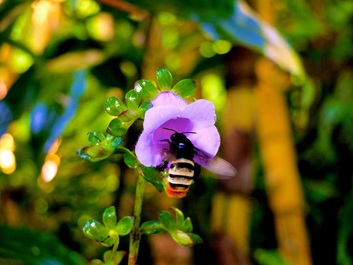 We've been away from internet for awhile now, time to catch up on here! Andrew already posted a blog about Bolita but it didn't include pictures so here you are! It was such an interesting little place, exactly what we were hoping for. I won't re-describe everything for you but there were a couple of things I wanted to add to Andrews notes. We had so much time to hike around and watch wildlife near Bolita. The picture here is from beside our table at breakfast. Hummingbirds, bees, monkeys, macaws, doves, geckos, etc. were always nearby.  This picture shows the nearly finished product of our volunteer work. We were asked to build a shelter over the clothes-line. We used bamboo which we cut down from a nearby bush, and some scraps that were lying around from previous projects. It took us two days (4-5 hours per day) to build and was very fun! We learned a lot about working with bamboo though didn't have any instruction - all by trial and error.  At one point Andrew got a bamboo cut on his thumb. At first he looked at it a bit nervously and insisted that he was ok when I asked. After a few minutes, he got off of the stump he was standing on and wobbled to the kitchen sink. I knew he was going to faint so I grabbed a stump for him to sit on while I held onto him from behind. (Note from Andrew - it was a really hot and sunny day of hard work, I was really just quite dehydrated! =P)
This is not the first time I've had to do this so was pretty routine, lol. When he was feeling up for it we cleaned it out well and stuck a bandage on it. It really wasn't too bad, but he said he got disturbed when it began to ooze dark blood. lol, funny day. The next day I got a couple of bamboo cuts as well (nothing bad) but it is worth noting that bamboo can be pretty dangerous for that! Super sharp! We wore gloves after a few warning cuts. The last few weeks have been a blast! After a couple action-packed weeks with my parents (so glad you guys were able to visit!), we decided to get back to nature and spent the last week at an incredible hostel called La Bolita located on the edge of Corcovado National Park. The place was great – exactly what we’d originally had in mind when we first planned on visiting Costa Rica. Although it was a bit of an adventure to get to ...
take a colectivo (mini-bus) about half an hour along the world's bumpiest road from Puerto Jimenez to Dos Brazos del Tigre, a town of about two hundred people. Once there, walk five minutes to the edge of town and then hike for half an hour up a steep jungle path, at one point wading through the Rio Tigre (don't worry, there aren't any tigers). ... for us this just added to the wonder of the place. Every morning we awoke to the sunrise and the sound of howling monkeys and screaming macaws (why does such a beautiful bird have to sound so horrible?), and spent the day hiking, nature-watching, relaxing in hammocks, and doing a bit of volunteer work. How could we ever go back to an office job after this?? Situated on sixty hectares of land that once contained a banana plantation, Bolita consists of a couple dorm buildings, a kitchen, a bathroom & shower building (with flush toilets), and a series of hiking trails through the old plantation and surrounding jungle. One morning we did an awesome hike that took us a couple hours through the jungle and up to a waterfall, after which we followed the Rio Tigre for a couple hours back down, hiking in water anywhere from ankle- to armpit-deep. We saw howler monkeys, white-faced (capuchin) monkeys, a couple small snakes, and a few jesus christ lizards running across the water and earning their names – amazing! We also ran into a couple local oreros (gold miners) panning for gold, which was a bit of a surprise for us. We were later told that there's a whole shanty town of gold miners who live in the jungle a four hour hike from town and pan various parts of the river. Because we stayed as volunteers, in exchange for about 20 hours of work per week, we got free accommodation along with unlimited beans & rice – finally a volunteer gig where we aren’t working AND paying. And since we didn’t realize there would be next to no groceries available in town, we ate nothing but beans & rice for the first couple days and saved a bunch of money on food (at least we had brought some hot sauce). Luckily, the owner Val was nice and picked us up a few things during her weekly trip to Puerto Jimenez, letting us to cook up some of the best pasta ever. The volunteer work was enjoyable, and we spent a couple days putting together a rain shelter for the clotheslines. We felt like proper rainforest pioneers chopping down a couple tall bamboo trees, splitting and cutting the bamboo, and lashing together a beautifully-engineered structure. Spending the week at the edge of Corcovado National Park has got us really excited for our next adventure – four days at La Sirena ranger station deep in the park. The plan is to catch a bus to Carate, the small town at the edge of the park, then early the next morning set out for the 20 km hike in along the beach. If we’re lucky, during our stay we’ll get to see tapirs, giant anteaters, pumas, jaguars, ocelots, crocodiles, bull sharks, a load of monkeys, and a plethora of frogs, lizards and birds. Also, if we’re lucky we won’t be seeing any of the many kinds of large, venomous snakes. Apparently there’s a very poisonous snake called the bushmaster (insert inappropriate comment here) that grows to be over three metres long and has been known to be aggressive, even at times chasing people through the jungle (or perhaps here). We’ll definitely have our hiking sticks and machetes out and will be ready to defend ourselves. =) We haven’t had much internet access lately and so haven’t had a chance to upload any photos, but once we’re out of the park and have settled somewhere in Panama we’ll be able to catch up and share some more stories. Until then, Pura Vida! - Mandrew 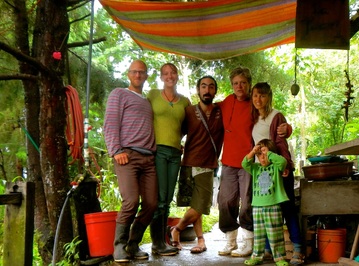 Andrew & I with Rafi, Suzanne, Flor & Fidel Andrew & I with Rafi, Suzanne, Flor & Fidel When we arrived at La Biosfera late Saturday night, we walked up the steep muddy driveway to the lodge area and met Suzanne, the owner who immediately poured us some mugs of the most delicious home brewed herbal tea. She is a VERY interesting character (check our her "Curious Character" profile). Originally from Buffalo, NY, Suzanne's an ex-marine now in her early 50’s, living on a piece of land she owns just outside of Jinotega. Although she lives alone, she has lots of visitors like us coming through all the time (though maybe not as many as she would like). In a few words I guess I would describe her as eccentric, tough and very generous! There was also an Argentine family staying there (Rafi, Flor and their 3 year old son, Fidel) when we arrived who were equally as interesting and mystical, but unfortunately they had to leave the next day. Rafi spoke the most English of them though we tried our best to speak in Spanish as much as possible (and then Andrew and I both had dreams in Spanish, FINALLY!). We talked about just about everything including the meaning of life, water vibrations, UFO's, herbal remedies, etc… Later, when we were getting ready for bed I told Andrew that I felt like we had stepped into – Andrew cut me off and finished my sentence perfectly – another universe… 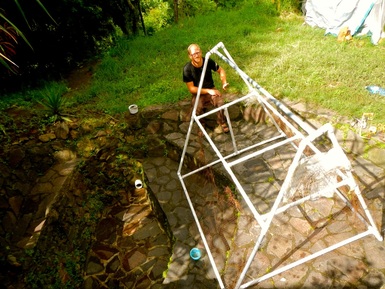 The PVC chicken coop structure coming together The PVC chicken coop structure coming together In the morning we got ready to start some work and said our goodbyes to Rafi, Flor and Fidel – we hadn’t known them for long but for some reason it felt like years. We took a tour of the property with Suzanne, which is huge and so green! There is a waterfall and small river, the bat cave is wicked cool, and the potential for forest preservation and education is enormous! There isn’t too much infrastructure there right now, and lots to do to get some more in there. We did some high priority work for the day including scrubbing the algae off of the walkway so no one would slip and fall. The next day we did some more manual work, as well as put our engineering skills to the test with the design of a lightweight, mobile chicken coop (which we chose to make out of PVC pipe, inspired by the photo booth structure Kim and Nate made for our wedding) as well as a support structure for the squash greenhouse. The chicken coop became our pet project for the next few days, and it turned out very well, we think. Assuming she can be caught, the pet chicken (originally known as "cena", meaning "dinner", but after many battles with the pet dog now known as "cena the warrior chicken") can chill in there now, along with some egg-laying hens Suzanne plans to buy from a neighbour. It was a really fun project even though Andrew and I had some trouble working together as we both like to take the lead on designs, lol.  Amanda and I putting the filling in the strudel Amanda and I putting the filling in the strudel After a few more days we got some new visitors! Michael and Amanda are in their early 20's and are basically searching for the meaning of life. They were kind of funny to talk to, and in a weird way, reminded me a bit of Andrew and I when we were their age travelling in Australia (oh so long ago now!). They were very enthusiastic about everything, and really seemed to take what we said, and anyone else said, to heart. We talked about all kinds of wacky, fun things such as, again, the meaning of life, vibrations, water, mermaids, fractals (patterns that repeat on all scales, for example the Fibonacci Spiral found in nature; snail shells; broccoli), free energy, the Bermuda Triangle (which by the way it looks like it could be the location of Atlantis based on some underground quartz pyramids! Seriously! Check Youtube!), pyramid power, DMT, etc. From what I gathered, Amanda grew up in a very religious family and had, only in the last couple of years, begun to question her beliefs. It must have been a very stressful and scary time for her, but now she says she is re-discovering the meaning in her life, and determining what is really important to her. Michael is a free spirit who appreciates nature more than most 20-year-old guys I've known. He thinks outside the box and is in search of new experiences. They make a very good couple, finishing each-other's sentences, sharing the same open-minded philosophies, and they are very supportive of each other. We had a really good time getting to know them over a few days. We even spent one evening making German Strudel with a Nica twist! I used the recipe that Oma taught me before we left the Yukon, but we had to substitute some of the ingredients (instead of apple and raisin filling, we used guava, passionfruit, raspberry extract & coconut oil), and we baked it in a wood-fired cobb oven so it tasted a little smokey which wasn't the best, lol. But it was still fun and turned out pretty well. When the time came to leave, we were very sad to say goodbye. In a very short amount of time we came to know Suzanne, Michael and Amanda surprisingly well. I would say the highlight of La Biosfera for me was the people, and the bonus was the place; nestled in the mountains and full of life. We made some possible plans to meet up with Michael and Amanda in a few months in Peru as they will be heading down there after a short stint back home - I hope we do see them again! We hope you enjoy our pictures, Andrew says that I post too many, but I really have a hard time cutting out any because I think that if they are good they should stay. He thinks that no one will look at them if we keep putting this many, but I guess I don't really mind if you don't, lol. What do you all think? Should we be putting limits on them? Or just keep going as we are so that in the future we can look back at this website and have all our photos on hand? That's my logic anyway... Sorry that we have been running behind on posting, the internet has been pretty terrible these last few weeks, but we are catching up now! Adios Amigos! -Chelsea To open in a new window click here.
|



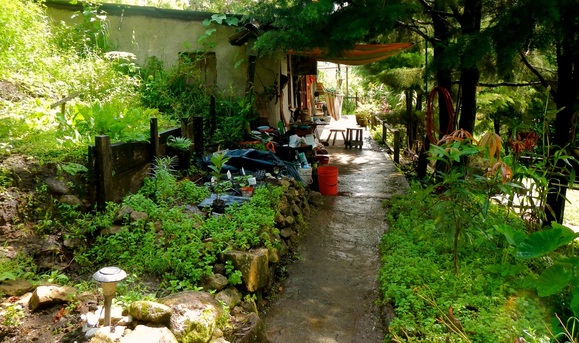
 RSS Feed
RSS Feed